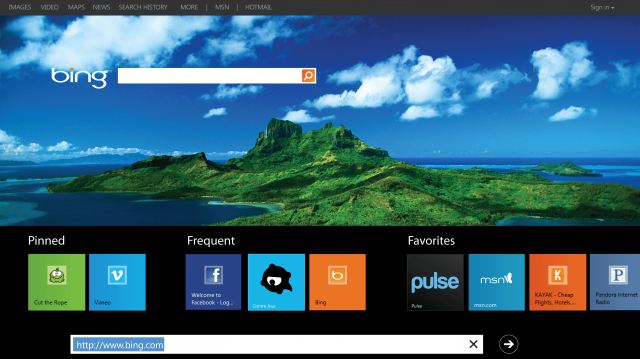
Microsoft has been heavily promoting its touch-centric browser since the launch of Windows 8. Internet Explorer 10 features a "chrome-less" interface intended to remove browser distractions and keep the user focused on the content. It's also gesture enabled, enabling users to pan, zoom, and swipe between pages. To get the browser to this point, Microsoft had to discover what exactly consumers were looking for from a tablet browser. The answer lay with iPad users.
Why “touch” first?
The goal behind making the browser touch-centric was to give it the same appeal and functionality of applications on tablets. "We did some research on consumer browsing and interaction," said Roger Capriotti, director of marketing at Microsoft, in a phone call with Ars Technica. His team had discovered that many users spend most of their time browsing and reading websites on the iPad through Safari rather than using an application that was available for a specific site.
"When folks read news sites on iPad, they're more likely, for example, to go the New York Timeswebsite in Safari than to download the [app] for iPad," explained Capriotti. "We realized that the tablet browsing experience is often left unstellar compared to the apps experience that you might have on these devices."
So Microsoft set its sights on creating a "touch-first" browser that could cater to tablet users. "When you look at the increasing popularity of tablets... speed is important, of course, but the most important feature for consumers isn't page load time but how quickly you can interact with it." Capriotti added that while elements like the speed of a browser are important, many browser developers haven't taken the difference in interaction between a desktop version of a browser and a mobile version into consideration.
Microsoft's next step was to commission a few research reports to validate the theory that tablet browsing is what matters to users. Microsoft worked with Penn Schoen Berland to query iPad users on their current browsing experience. Of 1,500 surveyed iPad users, 80 percent admitted that they had problems browsing the Web on their iPad. "They talked about how they preferred to have a better browsing experience on their iPad than they currently had with Safari," added Capriotti.
Redmond then worked with the Mozaic Group to show the iPad users the touch-enabled Internet Explorer 10 on a Windows 8 tablet to gauge their interest. Many said they would be interested in trading in their iPad just for the Windows 8 tablet's browsing experience. "If you take an iPad user... And show them [Windows 8] browsing, they get super excited about things like full-screen... the fact that my website is front and center and I'm not sharing it with a bunch of tabs along the side," said Capriotti. He added that those users were also interested in the browser's multitasking capabilities, where they could bring up a webpage and an app side-by-side and perform common tasks simultaneously.
The last study had been conducted with Principled Technologies and focused on performance, looking at common browser-based tasks like booking an airline ticket, sharing a website on Facebook, and shopping on an e-commerce site. "We were faster at doing those common tests—60 to 65 percent faster—than the iPad," said Capriotti, adding that much of that could be attributed to Internet Explorer's multitasking capabilities. "It was clear we needed to provide this solution to the Web that was above and beyond what was currently available."
Getting developers on board
To encourage this type of "touch-based" browsing, Microsoft created the "modern.IE" tool for developers to test their websites. The free tool includes developer resources for building websites that work across browsers rather than just prioritizing Internet Explorer. All developers have to do is plug in the URL of a site to retrieve results about how touch-compatible it is.
Microsoft has also submitted a standard to the W3C, called Pointer Events, that would enable developers to write to one set of input mechanisms that would work cross-platform. W3C states it does the following:
"The last thing you want to do if you're a developer is have to write a mobile site for iOS, a mobile site for Android, a mobile site for someone else, and then a desktop site," said Capriotti. "If they write the common Web standards and they take advantage of something like Pointer Events, they can actually build a site that works across all of these devices." Right now, it's in the Last Call Working Draft status at the W3C.
Update: The Pointer Events specification was promoted to Candidate Recommendation today.
Let’s not forget the robots
Microsoft's promotional video on how it built Internet Explorer 10.
In a promotional video, Microsoft illustrates how it employs a robotic probing tool called the PT3, a high-precision machine with sub-millimeter accuracy and a fake hand for drawing lines, tracing curves, and performing gestures—over and over again. The PT3 is part of the "Magic Fingers Robot," which is a fully automated system that runs these types of tests on a tablet device.
Currently, the touch-centric IE10 only works on Windows 8-capable devices and there are no plans to bring it to other platforms at this time. You can read more about how Microsoft worked on Internet Explorer 10 at its official blog.
No comments:
Post a Comment
Let us know your Thoughts and ideas!
Your comment will be deleted if you
Spam , Adv. Or use of bad language!
Try not to! And thank for visiting and for the comment
Keep visiting and spread and share our post !!
Sharing is a kind way of caring!! Thanks again!